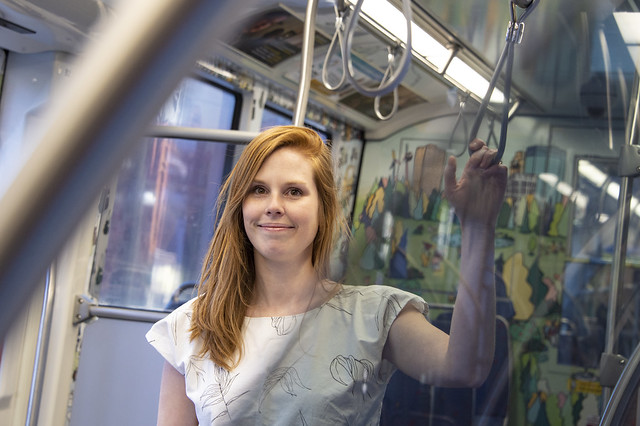
A light rail vehicle carrying METRO Green Line customers to their destinations now doubles as a work of art.
The outside of the vehicle shows a caterpillar becoming a monarch butterfly. Inside, the walls are covered with illustrated scenes of moose, mice and other furry creatures exploring local landmarks like the Minneapolis Sculpture Garden in every season.
The unique display is the culmination of a partnership between students at the University of St. Thomas, St. Paul-based artist Sarah Nelson and Metro Transit.
Last fall, students in a Leadership for Social Justice course conducted a series of interviews about the connections between transit, sustainable communities and social justice.
The interviews provide the foundation of a recently published book, Transit Transformations. Nelson’s hand-drawn illustrations of a monarch butterfly adorn the cover of that book and were adapted for the exterior of the light rail vehicle.
The monarch was chosen for the book cover because transformation was a common theme in the interviews.
The illustrations inside the light rail vehicle were purely Nelson’s vision.
“You might think of it as (children’s book author and illustrator) Richard Scarry meets Where’s Waldo, but with my own spin,” Nelson said as she saw the finished product for the first time. “I hope that this artwork engages people of all ages and captures fun.”
Transferring Nelson’s designs to such an unusual canvas took hundreds of hours and careful planning. Advertisements are regularly applied to the outside of light rail vehicles, but they rarely take over the inside the way Nelson’s illustrations do.
The unusual display was made possible by an arts program connected to St. Thomas’ Sustainable Communities Partnership. Through the partnership, students work with community partners on projects that support human and environmental well-being.
The project was also supported by the SOLV Initiative, a St. Thomas’ College of Arts and Science program that, in part, seeks to support the public interest through arts and the humanities.
The artwork will remain in place through at least the end of May. But Professor Mike Klein, who led the students whose interviews provide the foundation for the book and light rail artwork, said he hopes it leaves an impression that lasts well beyond its lifetime.
“We hope this artwork will capture the rider’s imagination,” he said. “And to help us imagine a world we want to see.”
